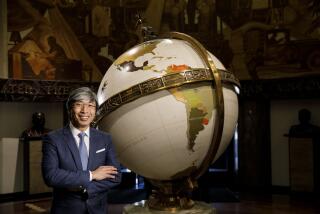L.A. Times reporter Angel Jennings is named newsroom head of culture and talent

Los Angeles Times reporter Angel Jennings will be the newspaper’s first assistant managing editor for culture and talent, part of the media company’s efforts to reform hiring practices, increase staff diversity and overhaul how it treats Black and Latino journalists and communities.
Jennings, 35, joined The Times nine years ago and is the only Black reporter in the department that covers local and California news. In recent years, she has extensively written about South L.A. Her in-depth coverage of rapper Nipsey Hussle’s death was widely praised for discussing his role not only as a musician but also as a champion of the community where he grew up. Jennings’ story about Hussle’s last moments was The Times’ most-read story of 2019.
Jennings will join the group of senior-most editors, known as the masthead. In this position, she will oversee recruiting efforts and staff development initiatives. She will also be in charge of internships and The Times’ Metpro diversity fellowships — the program through which she joined the paper.
“I am so grateful for this opportunity to be able to help the paper as it enters its next chapter of attracting more readers, reflecting the community and really meeting this moment,” said Jennings, whose recent work has also included stories on gentrification in South L.A., a narrative about a nurse watching her father die of COVID-19 and coverage that resulted in the disbanding of a Compton water district. “The success of the industry depends on us actually talking about and telling the stories of communities that look like the readers of the future. I’m just really excited about being able to be part of that.”
Executive Editor Norman Pearlstine announced the position’s creation in June, as police violence against Black Americans sparked protests across the country and raw and painful discussions about the newsroom’s mistreatment of Black and brown journalists and its coverage of communities of color. Staffers of color spoke of being undervalued and marginalized, of battling a myopia that centers the perspectives and interests of white and wealthier Angelenos. They described being passed over for raises, plum assignments and opportunities to advance.
In an emotional staff meeting that lasted more than four hours, Times staffers voiced concern about the newsroom’s hiring and retention practices. Staffers criticized newsroom leaders for not prioritizing diversity during a hiring spree of more than 160 people after biotech entrepreneur Dr. Patrick Soon-Shiong bought The Times in 2018 from newspaper chain Tronc.
As of June, The Times’ editorial staff consists of 502 employees, 61% of whom are white, though the population of Los Angeles County is only 26% white. Latinos make up almost half of the county’s population but represent just 12.9% of The Times’ newsroom. The Times has 26 Black journalists — making up 5.2% of the staff — in a county that is 7.8% Black. At 14.7%, the percentage of Asian Americans at The Times mirrors that of the county’s population.
This summer, unionized members of the newsroom formed a Black Caucus and a Latino Caucus, which met with newsroom leaders and the Soon-Shiong family who promised that The Times would hire more journalists from underrepresented backgrounds, enhance resources to help Black employees advance and evaluate staff compensation each year to make sure employees are paid equitably.
In response to staff outrage, there have been changes in the newsroom, including weekly updates on diversity initiatives and an internal audit of protest coverage. Jennings’ appointment to the masthead marks the most concrete change so far.
“One of the things with the protest movement migrating from the streets into the newsroom was a recognition that we have been deficient in terms of embracing the importance of culture and the importance of transparency that comes with that,” Pearlstine said. “Angel demonstrated in all of the interviews a keen understanding of the kinds of things the newsroom is looking for, in terms of leadership, in terms of hiring, in terms of training and retention.”
Positions focused on diversity and inclusion have become important roles in the journalism industry and beyond. For example, the Washington Post recently established a managing editor position focused on diversity.
But a title alone can’t make a workplace more inclusive.
“We have a lot of work to do,” Pearlstine said. “I don’t want to in any way suggest that one person changes that. It’s really part of a broader effort to embrace the commitments that have been made in terms of both hiring and training and promoting and retaining, but also in terms of coverage, and I think having [Jennings] at the table when we decide how to allocate resources for different things will also be very helpful.”
It will take more voices with diverse experiences to bring about long-lasting change, Jennings said. This position, she said, shows a firm commitment from newsroom leadership and ownership.
“It’s not one person. It’s not one position,” she said. “It takes so many people in every department from the ground up to the top.”
More to Read
Inside the business of entertainment
The Wide Shot brings you news, analysis and insights on everything from streaming wars to production — and what it all means for the future.
You may occasionally receive promotional content from the Los Angeles Times.











